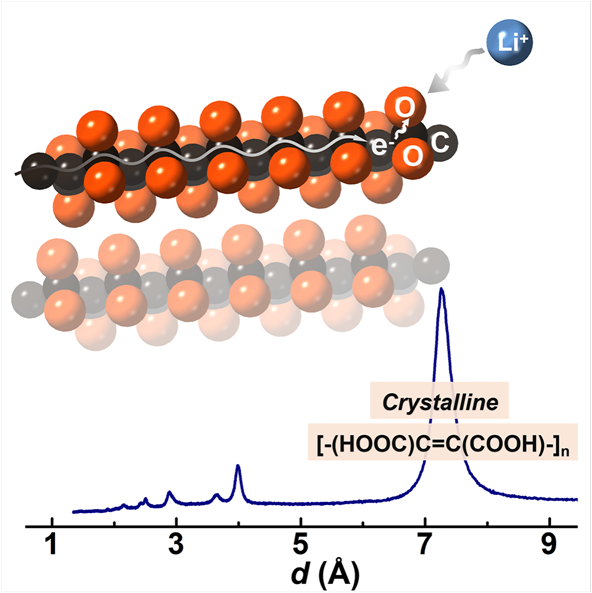Crystalline Fully Carboxylated Polyacetylene Obtained under HP as a Li-Ion Battery Anode Material – Dr. Haiyan Zheng
DECEMBER 28, 2021
Organic carbonyl compounds have been widely studied as promising electrode materials for lithium-ion batteries (LIBs) because of their availability, easy modification, high theoretical capacity, and fast electrochemical kinetics. For practical usage, a large number of carbonyls needs to bond to a conductive polyacetylene backbone to realize optimized capacity, electronic conductivity, and solubility. However, it is tough to synthesize this kind of materials by traditional methods.
Now, groundbreaking new research by a team led by HPSTAR's Dr. Haiyan Zheng reports a completely functionalized crystalline polyacetylene produced from solid acetylenedicarboxylic acid (ADCA) using high-pressure techniques - the first crystalline poly-dicarboxylacetylene with every carbon on the trans-polyacetylene backbone bonded to a carboxyl group. Its unique structure combines the extremely high content of carbonyl groups and high conductivity of a polyacetylene backbone, exhibiting high specific capacity, high Coulombic efficiency and excellent cycling/rate performance as a LIB anode. Furthermore, this work, published in the latest edition of the Journal of Physical Chemistry Letters, offers a high-pressure solution for synthesizing polymeric LIB materials and other polymeric materials with high active group content.
Using a suite of high-pressure techniques, including powder X-ray Diffraction, infrared absorption spectra, in-situ time-of-flight neutron diffraction, Dr. Zheng’s group synthesized crystalline poly-dicarboxylacetylene from ADCA under high pressure, and investigated its application in LIB anode materials.

The solid ADCA experienced a topochemical polymerization process, bonding its C≡C bonds, generating trans-polyacetylene chains with every carbon atom connected to a carboxyl group. The intermolecular hydrogen bonds play a key role in maintaining the crystallinity of the pressure-induced polymerization product.
The crystalline poly-dicarboxylacetylene also retains carboxyl groups, but with reduced solubility and improved electrical conductivity due to the conjugated backbone. This makes it a potential LIB anode material with a high specific capacity, excellent cycle stability, and excellent rate performance.
The study provides an unprecedented high-pressure route for the tailored synthesis of polymeric LIB materials with a high content of REDOX active groups. Excitingly, via introduction specific functional groups into the reactant and following this novel topochemical PIP strategy, more polymeric materials with designed functions are expected in the future.
含有丰富的碳、氢、氧等元素的有机电极材料因其资源可再生、结构可设计、高比容量和快反应动力学等优点被认为是极具发展前景的下一代锂离子电池材料,近年来受到了广泛的关注。然而,该类材料仍面临电导率低、易溶解于有机电解液等问题,导致其能量密度较低、容量衰减较严重、循环稳定性较差。因此,设计合成具有高容量、高导电率、高稳定性的有机电池材料是锂离子电池研究中的重要挑战。全羧基修饰的聚乙炔——聚丁炔二酸是锂离子电池的理想候选材料之一。然而,使用传统的催化合成和辐照合成方法难以实现精准调控,且反应产率低。近日,北京高压科学研究中心郑海燕课题组报道了丁炔二酸在压力驱动下发生拓扑聚合反应获得了晶态的聚丁炔二酸,其中反式聚乙炔骨架上的每个碳都与一个羧基结合。他们发现分子间的氢键在维持反应有序性和产物结晶方面起着关键的调控作用。聚合产物的独特结构实现了高羰基含量和高导电性聚乙炔链的有效结合,从而提高了材料的电导率和稳定性,用于锂离子电池负极材料表现出高比容量、高库伦效率(99%)和优异的循环/倍率性能。该项工作为合成聚合物锂离子电池材料和其他高活性基团含量的聚合物材料提供了一种新型的高压合成方法,并有望通过这一拓扑聚合路径得到更多具有设计功能的晶态高分子材料。相关研究结果发表在Journal of Physical Chemistry Letters (DOI: 10.1021/acs.jpclett.1c03734)上,文章第一作者为北京高压科学研究中心博士研究生王萱。
